Once upon a time, I could not do one pull-up. Heck, I couldn’t do a push-up, either. I used to ask my mom to write me notes to get me out of gym in school, since I dreaded the very thought of Phys. Ed. I was the last one picked for every team sport, and I was bullied a lot.
Well, times have changed, and at some point in my twenties, I figured out how to get my body to do what I wanted it to do, and I got my first pull up. Now I do them with 20kg hanging from my waist, and they are one of my all time favorite exercises.
People have been asking me a lot lately about how to get their first pull up, or how to improve the number of pull ups they can do. This seemed as good a time as any, then, to put together a little article on some things that helped me get my pull ups honed in.
First of all, let me tell you what did NOT work for me. That’s not to say that these might not be useful exercises for other people. I find that what tends to work for the majority tends not to work for me, so I could be an anomaly.
- Lat Pulldowns. I believe these did not work for a few reasons. First of all, there is only so much you can pull without the barrier on your legs – at some point you’ll fly up with the bar. The barrier recruits your hip flexors, which should not be pulling to that degree (or at that angle) in a proper pull up. Second of all, the lat pulldown does not mimic the mechanics of the pull up, making it a poor assistance exercise for this movement.
- Assisted pull up machines. I never approached a bodyweight pull up using these things. The standing variety of this machine seems to be a little bit better for mimicking pull up mechanics than the kneeling kind. However, in both cases, although my ability to do a machine pull up improved, my ability to do a bodyweight pull up did not. Elastic band assistance had the same effect for me.
I know these methods did not work for me because at the time, they were all the training I did to try to achieve a pull up. Fortunately, I wised up and tried some new methods. And what I realized is that if you want to be able to do pull ups, you need to start doing pull ups and all their elements. Period.
RELATED:How Bands Are Actually Holding You Back
Here Are the Ten Tools I Used to Get Better at Pull Ups:
1. Hanging
If you’re going to pull yourself up from a hanging position, you’d best learn how to hang first. Many people find just holding on to the bar is the most challenging part of the pull up. I’ve said it before, and I’ll say it again – a strong grip leads to a strong upper body. So get your hang on.
Try to hang from a bar for as long as your hands will let you. If your grip is already pretty strong, you can try things like thick bar hangs (use thick grips, or wrap a towel or other similar material around the bar to make the bar as thick as you like), two-finger hangs, one-finger hangs, one-arm hangs, and so on. To make things more challenging, try weighting yourself or changing your leg position. I like to do hanging leg raises from my one-arm hang position.
RELATED:Why Unpacking the Shoulder in Pull Ups Is Helpful
Pictured here are a two-finger hang and a one-arm hang:
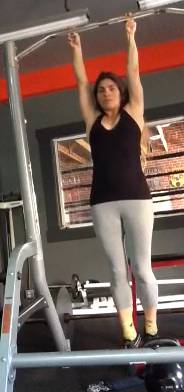
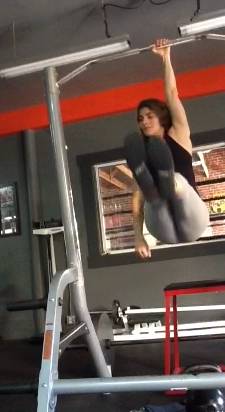
2. Scapular Pull Ups
Scap pull ups are really good for people who have trouble activating their lats (which should be the first move you make in a pull up). The ability to hang with straight arms, and then pull your shoulder blades down your back, is an excellent way to learn how to initiate a pull up with your lats and make your back stronger for pulling.
LEARN MORE: Developing Your Serratus Anterior
3. Batwings
I learned about batwings from the ever-amazing Dan John. Essentially, you lie facedown on a bench with a relatively heavy kettlebell or dumbbell in each hand. Pull the weights all the way up with the intention of touching your thumbs to your armpits, and squeeze your shoulder blades together for 5+ seconds. This is a fantastic way to help increase your pulling strength.
MORE HERE:Strength Routines for Developing a Strong and Healthy Upper Back
4. Bottoms-Up Holds and Presses
Bottoms-up kettlebell work increases your crush grip strength, your core strength, and your shoulder stability, which might just give you the edge you need to increase your pull up strength.
Pictured here is the bottoms-up clean, bottoms-up press, and double bottoms-up clean:
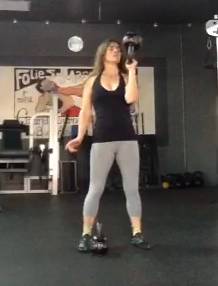
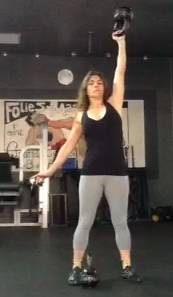
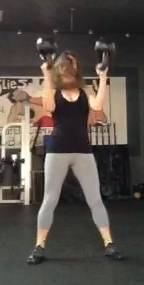
FURTHER INSTRUCTION:4 Drills That Will Improve Your Kettlebell Press
5. Bananas
If you are going to do a really good pull up, you are going to need to learn how to create a gymnastic-type “hollow” position with your body. Bananas create this kind of position from the ground, and give you some excellent abdominal strength, too.

Basically, shove your lower spine into the ground from a lying-down position. Try to remove all the air between your lumbar curve and the floor. Stick your legs together and lock your knees. Lift your shoulders and your legs a bit off the floor, and put your arms straight behind you in line with or behind your ears. Hang out there as long as you can stand it. For more of a challenge, try to maintain your position and rock back and forth.
INSTRUCTIONAL VIDEO: Hollow Hold (Bananas)
6. Reverse Bananas
From your pushup position, keep your tailbone tucked and walk your hands out in front of you as far as you can. Hold for time.
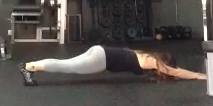
7. Ground pull ups
Assume your banana hollow position on the ground. Now grab a bar at pull up height (either with a partner holding it, or with some sort of creative maneuvering like I did in the video). Pull your shoulder blades down your spine and maintain your banana position. Pull your body up until your throat is level with the bar. Lather, rinse, repeat.
READ MORE:Women and Pull Ups: 3 Secrets You’ve Probably Never Tried
8. Isometrics
You may know by now that I am a huge fan of isometrics for building strength. For pull ups, I like to do weighted holds in my weakest areas for 5-10 seconds (for me, it’s the top of the pull). I also do a lot of bodyweight and weighted pull up isometrics at various levels of the movement. I found this to be extremely useful for building strength for heavier pulls.
PRACTICE IT:Working at a Stand Still: How to Do Isometric Training
9. Negatives
This is the only kind of negativity I allow in the gym. Use a step or a boost or a jump to get your body to the top of the bar so that your chin is over the bar. Ideally, start with your throat level to the bar. Hold that top position for a few seconds, and lower yourself very slowly until your arms are straight. These days, I have been doing my negatives with 24kg and above to help meet my goal of a 24kg weighted pull up.
LEARN MORE:6 Powerful Benefits of Eccentric Training
10. Partner-Assisted pull ups
If you can’t quite get your pull up, recruit a partner to help you. Instead of grabbing your feet or lower legs like many people do (which gets you out of form and allows you to recruit your legs to push you up), have them support you behind your ribs. Make sure you maintain proper pull up form throughout the movement, and only allow your friend to help as much as is needed.
RELATED:Having a Workout Partner Can Double Performance
Common Mistakes I Have Seen With the Pull Up:
- Pulling up with bent hips and knees, or “pumping” your way up. A really good, strict pull up should not recruit your hip flexors or use momentum to achieve the end result. Keep your body in banana hollow position!
- Shrugging the shoulders and dropping the chin to the chest while pulling. Trust me – this makes you weaker, recruits the wrong muscles for the movement, and might give you a nasty headache. And it ain’t pretty to look at, either.
- Not extending the arms all the way at the bottom of the movement. If you start or finish your pull ups with a bent arm, you didn’t complete the pull up. And you’re a big ole cheater.
Hopefully some of this will get you well on your way to your pull up goals. Use what works for you and throw out what doesn’t. Everyone’s body is different, so you may find that you do better with some of these than with others.
Make sure you train your weaknesses hardest, even though that’s not as much fun. When it comes down to it, the weak links are what will make or break your results. Let me know how you do!






